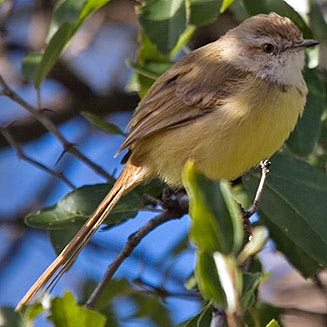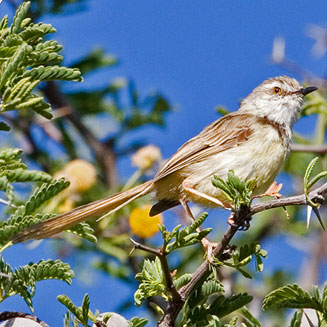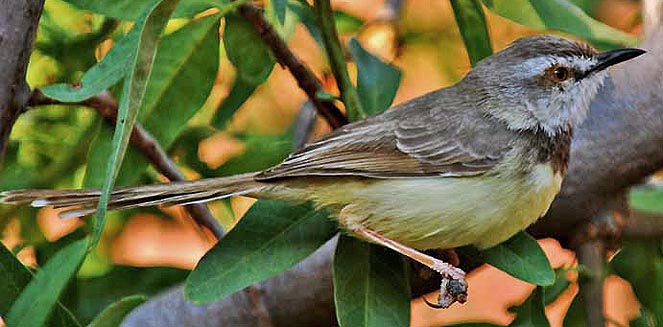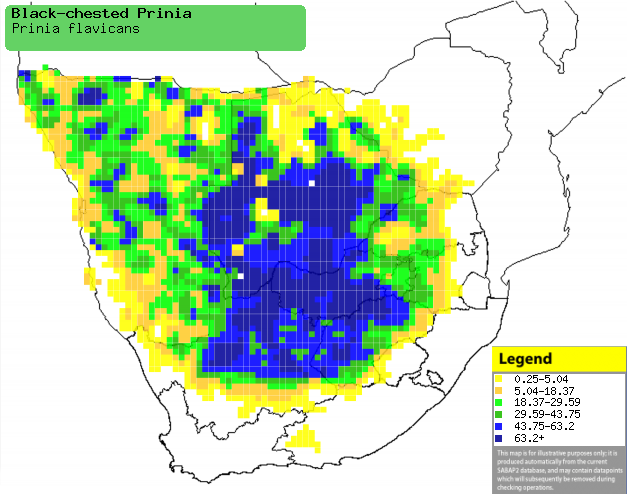|
Prinia flavicans (Black-chested
prinia)
Swartbandlangstertjie [Afrikaans]; Harudeve (generic term
for cisticola or prinia) [Kwangali]; Motintinyane (generic term for cisticolas
and prinias) [South Sotho]; Tôntôbane [Tswana]; Zwartborstprinia [Dutch];
Prinia à plastron [French]; Brustbandprinie [German]; Prínia-de-colar-preto
[Portuguese]
Life
> Eukaryotes >
Opisthokonta
> Metazoa (animals) >
Bilateria >
Deuterostomia > Chordata >
Craniata > Vertebrata (vertebrates) > Gnathostomata (jawed
vertebrates) > Teleostomi (teleost fish) > Osteichthyes (bony fish) > Class:
Sarcopterygii (lobe-finned
fish) > Stegocephalia (terrestrial
vertebrates) > Tetrapoda
(four-legged vertebrates) > Reptiliomorpha > Amniota >
Reptilia (reptiles) >
Romeriida > Diapsida > Archosauromorpha > Archosauria >
Dinosauria
(dinosaurs) > Saurischia > Theropoda (bipedal predatory dinosaurs) >
Coelurosauria > Maniraptora > Aves
(birds) >
Order: Passeriformes > Family: Cisticolidae
> Genus: Prinia
 |
 |
|
Black-chested prinia, in breeding plumage. [photo
Neil Gray
©] |
Black-chested prinia, in non-breeding plumage. [photo
Neil Gray
©] |
 |
|
Black-chested prinia, in breeding plumage. [photo Callie de Wet ©] |
Distribution and habitat
It occurs from southern Angola and Zambia to southern
Africa, where it is common in shrubland (in both arid and semi-arid climates),
dry Acacia savanna with scattered bushes, edges of drainage woodland in
dry areas, fallowed cropland with large bushes and gardens in rural villages.
|
 |
|
Distribution of Black-chested prinia in southern
Africa, based on statistical smoothing of the records from first SA Bird
Atlas Project (©
Animal Demography unit, University of
Cape Town; smoothing by Birgit Erni and Francesca Little). Colours range
from dark blue (most common) through to yellow (least common).
See here for the latest distribution
from the SABAP2. |
Brood parasites
It has been recorded as host of the
Brown-backed honeyguide.
Food
It eats a variety of small invertebrates gleaned from
leaves, stems and bare soil. The following food items have been recorded
in its diet:
- Insects
- Arachnids
- Nectar
- Aloe greatheadii (Spotted aloe)
- Kniphofia (red-hot pokers)
- Grevillea robusta (Silky oak)
Breeding
- The nest is built by both sexes in roughly 11-12 days, consisting of a
thin-walled oval or pear-shape with a side-top entrance, built of woven
green grass which eventually become dry and pale brown. It is typically
placed about 1 metre above ground in the stems of a bush, shrub, thorny tree
or sapling, or occasionally a clump of tall grass.
- Egg-laying season is year-round, peaking from September-April. It may
breed opportunistically after rainfall in Winter, while it is still in
non-breeding plumage.
- It lays 2-6 eggs, which are incubated for about 12-15 days.
- The chicks are fed by both parents, leaving the nest after about 11-15
days.
Threats
Not threatened.
References
-
Hockey PAR, Dean WRJ and Ryan PG 2005. Roberts
- Birds of southern Africa, VIIth ed. The Trustees of the John Voelcker
Bird Book Fund, Cape Town.
|
